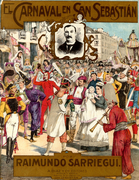Donostia / San Sebastián: European Capital of Culture 2016
ERESBIL-Basque Archives of Music
Thursday, January 21, 2016

Donostia, the Basque name for San Sebastián in Spain, is one of the two European Capitals of Culture in 2016. Donostia joins Wrocław, Poland for year-long festivities of theater, music, dance, exhibitions, and more.
Our colleagues at ERESBIL-Basque Archives of Music (E-RE) have written an overview of music life in Donostia (Spanish version here):
Sometimes there are composers that are known by one work. This is the case of Mateo Albéniz (1755-1831), whose keyboard Sonata en D was introduced by Joaquin Nin in 1925. Today the original is lost, as are his previous works up to 1813. On that day, under the Napoleonic wars, English and Portuguese troops set fire to the city of San Sebastián, with great loss of lives and property, including the parish music archives, whose chapel-master was Albéniz. It was from that date that the city reinvented itself, converting music into one of the preferred popular activities. Pedro Albéniz, son of the chapel-master and piano teacher at the Conservatory of Madrid, composed popular music for Carnival. Festive music was reinvented throughout the 19th century by José Antonio Santesteban and Raimundo Sarriegui.
A city dedicated to hosting international tourism relies on music to develop, from the Belle Époque and during the 20th century, a solid educational structure that illuminate composers from Beltrán Pagola to José Mª Usandizaga, José Antonio de Donostia, Pablo Sorozábal, and Francisco Escudero; or Ramon Lazkano, who currently gives classes at Musikene, Higher School of Music of the Basque Country, whose new building will be inaugurated in 2016. Organizations like the Orfeón Donostiarra or the Basque National Symphony Orchestra are a necessary part and support cycles and festivals like “La Quincena Musical,” dean of classical festivals in Spain, or the Jazz Festival. New organizations replace the old chapels of music, whose documentary trail in the Basque territory from Gipuzkoa is located in the Franciscan monastery of Arantzazu. In its archive there are echos of San Sebastian’s music activity in the 18th century. Three centuries later San Sebastian, with Wroclaw, Poland, the city that shares the capital status, invites you to the festivities of the 2016 European Capital of Culture during the year. Ongi etorri! Welcome!
The RISM catalog of library sigla lists four institutions in San Sebastian: Archivo Histórico Diocesano de San Sebastián (E-SSahd), Museo San Telmo (E-SSmst), Biblioteca del Conservatorio Profesional de Música “Francisco Escudero” (E-SScp), and Mediateca del Centro Superior de Música del País Vasco (E-SSc).
Below, enjoy Mateo Albéniz’s Sonata en D performed by Paco Cánovas.
Image: Sarriegi - Music of Carnival, edited in 1898. Courtesy of ERESBIL-Basque Archives of Music.
Share Tweet EmailCategory: In the news

